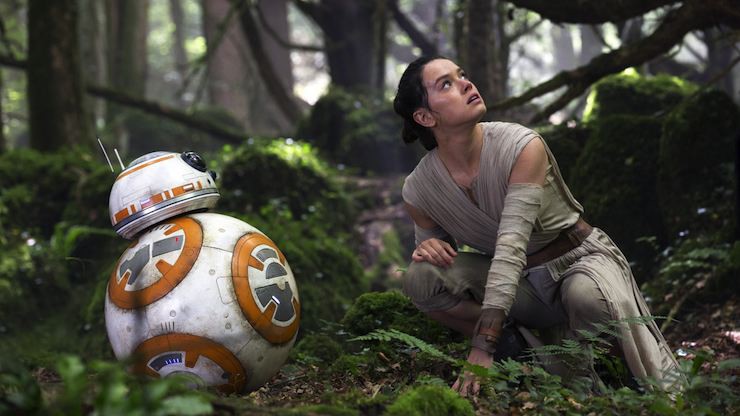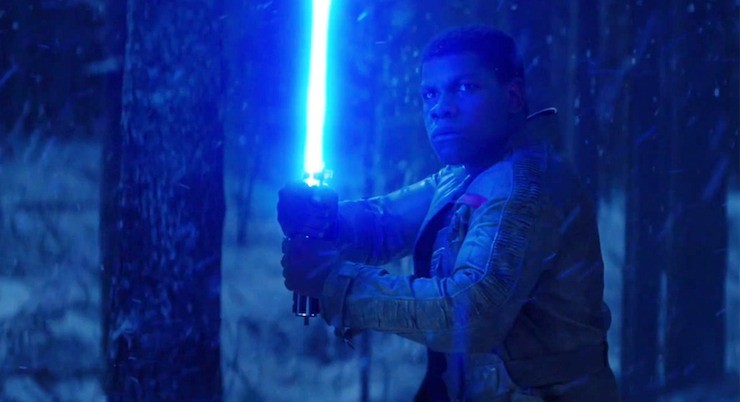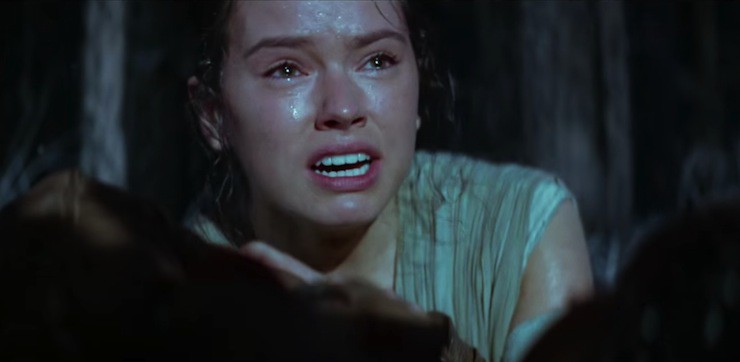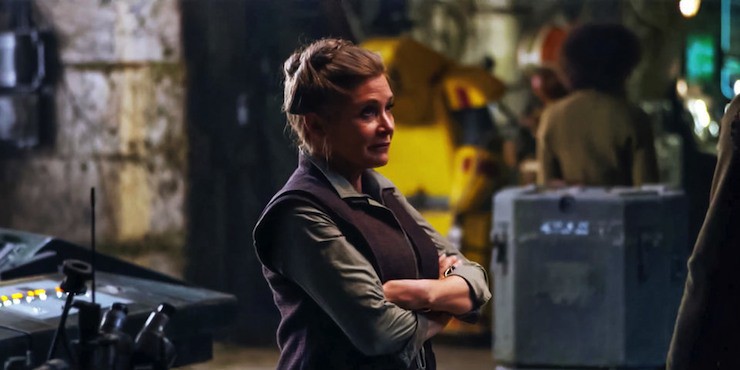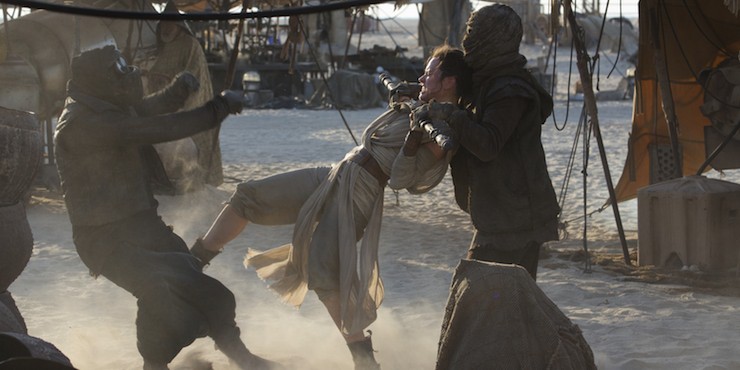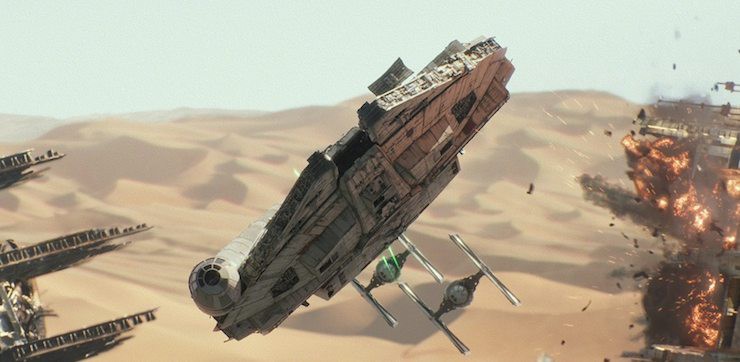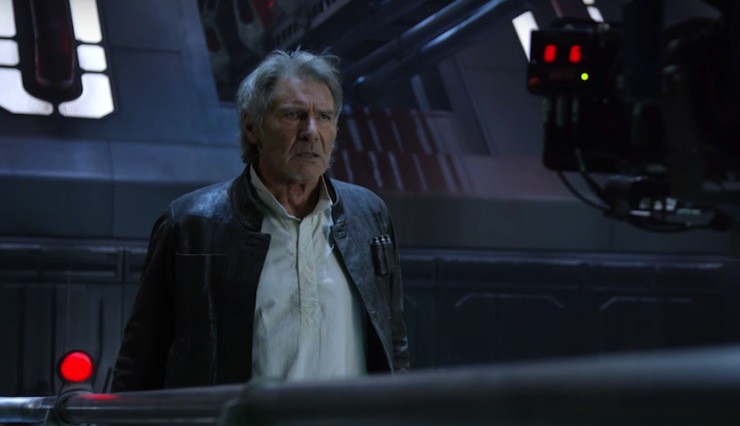Watching the behind the scenes footage of films is something of a pastime for me, so I plowed right through all the special features on my Star Wars: The Force Awakens Blu-Ray. Want to hear some of the cutest/coolest tidbits?
[Spoilers for The Force Awakens below.]
The lightsabers cast light because the lightsaber props are totally different from previous versions
One of the most impressive feats in Episode VII was the fact that the lightsabers appeared to be casting strong light in their environments. It seems like a given, but that hasn’t really been the case for previous Star Wars films; the light they cast before was typically weak or totally circumstantial (i.e. ‘would light from the lightsaber look cool here?’). The reason why light was present in The Force Awakens is because the prop lightsabers actually contained lit blades for the first time ever—before, they were simply metal rods that the light effect was grafted onto. This was likely a huge triumph for the prop department, as lightsabers with lit blades have never been durable enough to withstand serious abuse before. (Ask anyone who’s ever broken their beloved FX lightsaber.)
Mark Hamill read the script for the first read-through
It’s tradition for the director to read the script at the first table read for a film—that’s all the stage directions, setting descriptions, etc.—but for the Episode VII, Abrams asked Mark Hamill to read. Aside from being a sweet gesture, it also makes sense, as Hamill had no actual lines to read in the script itself. Daisy Ridley and John Boyega reported both feeling as though they were still auditioning in that first readthrough—Ridley thought she was awful in it.
Daisy Ridley got the part of Rey by crying a lot
Abrams said the audition where they knew Daisy Ridley was “the one” was for the interrogation scene between Rey and Kylo Ren. During the audition, tears were streaming down her face. Abrams stopped her and asked her to do the scene again, and seeing that she could bring emotion like that consistently was what got her the part. John Boyega reportedly auditioned for Finn nine times before being cast, proving that no matter how long the process goes on, you’re still in the running if you’re still auditioning. When Abrams told Boyega that he got the part, the director told him “No, don’t react. Stay calm. Breathe.”
No one knew how to pronounce Kylo Ren
The special features are full of people pronouncing Kylo Ren’s name “Kee-lo Ren” before they knew better. (Almost as though they subconsciously knew it would upset the guy.) Adam Driver claimed that getting his costume on was such a hassle that by the time he was fully clothed, he was perfectly angry enough to play the part. Boyega said that Driver was quite the opponent in their brief duel, and Ren’s fierceness prompted him to hit back harder.
Carrie Fisher’s first day on set was horrible
According to Fisher, she was terrible during her first day of shooting. Abrams put it down to nervousness, noting that it had been a while since Fisher had stepped in front of a camera. She said that she got sleep, came back, and everything was better the next day. It was dearly important to her to get everything right, as she considers herself the “custodian” of Leia. Hamill, Ford, and Fisher all talked about how they didn’t see each other often in the years between these films, but being together was just like old times.
There is a deleted snowspeeder scene and it’s super cute
Among the deleted scenes is an adorable bit on the surface of Starkiller Base where Rey and Finn get into a fight against First Order snowtroopers in a high-speed snowspeeder chase. When it starts, Finn is piloting and Rey has a blaster, but Finn quickly realizes that they have it backwards—he has Rey dive into the driver’s seat and grabs the blaster for himself, then dispatches the snowspeeder on their tail in short order.
Daisy Ridley had to build a ton of arm muscle to play Rey
Ridley talks about how all the weapons that she practiced with were made of lightweight materials. The film props, on the other hand, were properly heavy for someone of her size. Both Ridley and her stunt double have very small arms, so their major goal was building enough muscle to be able to wield these weapons for hours at a time (since filming is often a full-day affair). The running scenes on Jakku were also incredibly intense. Some of Ridley’s very first filmed scenes were opposite BB-8, and so the droid has a very special place in her heart for being the first “person” she got to interact with.
The final lightsaber fight in the snow takes place on a set
That forest is a set. A beautiful set. They made it on a soundstage, and hand painted the background in the distance. Abrams had expected to have to find a location for the scene, but the designers presented a plan to create a closed environment that would do the job, and Abrams let them build it, real trees and all.
The Millennium Falcon in Episode VII is practically identical to the first model in A New Hope
Everyone who worked on the Falcon for The Force Awakens was able to go through the Lucasfilm Archives and check out pictures of the Falcon‘s model design from 1977. What they found were a bunch of flourishes from the initial designers—stickers and decals and the like—and they decided to reproduce that Falcon as faithfully as possible. Though they knew that most of those details wouldn’t really read on film, they were happy to know they were there.
Star Wars environments are still conceptualized ahead of time
One aspect that has always set Star Wars apart from most other film projects is that the conceptual phase starts well before the film is underway. Most prop and effect houses get orders for precisely what a film requires, but Star Wars works in the opposite direction; the creative teams are expected to conceptualize new aliens, droids, environments, and then offer them up for inspection. Essentially, Star Wars designers have carte blanche to go wild on the creation front, and hope that whatever they make is good enough to get into the film. It’s how places like the Neema Outpost on Jakku, and Maz’s temple get created in the first place. A variety of techniques are always in play, from motion-capture to traditional puppetry to prosthetics.
Harrison Ford was totally happy to die
Ford had already pulled for Han Solo to die in Return of the Jedi, over thirty years ago, and he was perfectly happy with Han’s fate in Episode VII. In addition, he warned one of the crew members constructing the Falcon to get working toggle switches for the cockpit; apparently, they didn’t have the money for working parts in the first film, so all the toggle switches on the Falcon would gradually shift from one position to the other during takes because they had no springs in them. He also questioned the position of everything in the Falcon cockpit when he got on set, despite the fact that it was reproduced faithfully. When he gave his now famous line—”Chewie, we’re home”—200 people showed up on the set to watch the monitors as it happened.
Star Wars is not a film, it’s an experience
Somewhat magically, Carrie Fisher and Harrison Ford say—in separate interviews—that they don’t think of Star Wars as a series of films anymore, but a “family experience,” something of resonance that gets passed on from generation to generation. Adding to that sense of family experience were the significant number of crew members on Episode VII who had parents that worked on the original trilogy. Gwendolyn Christie felt similarly, saying that while she knew Star Wars was a film, it was also more; a universe where she felt a person like herself could belong. *sniff*
There’s loads more, but those were some of my favorite moments. Feel free to talk endlessly about BB-8’s puppeteers below, as they are true heroes.
Emmet Asher-Perrin wants to keep Daisy Ridley and John Boyega in her pocket. You can bug her on Twitter and Tumblr, and read more of her work here and elsewhere.










